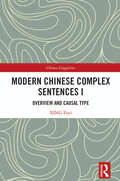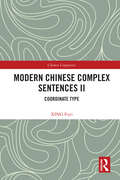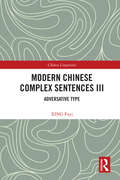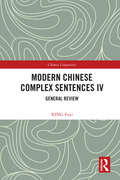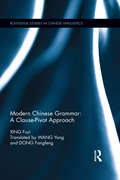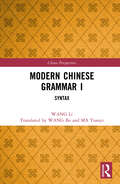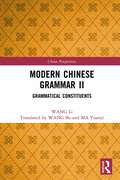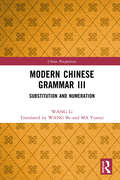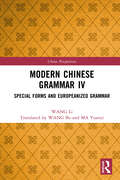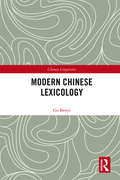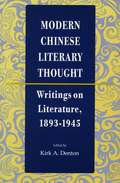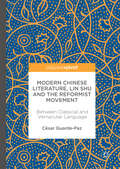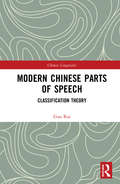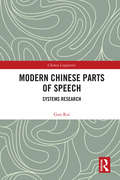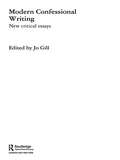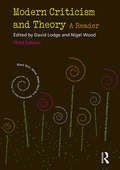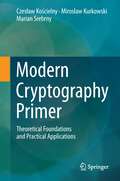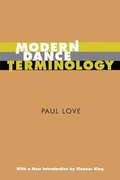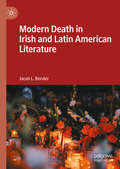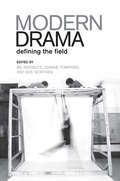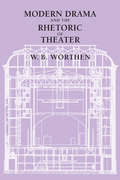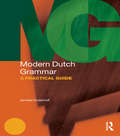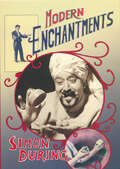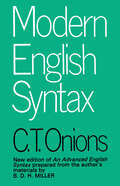- Table View
- List View
Modern Chinese Complex Sentences I: Overview and Causal Type (Chinese Linguistics)
by XING FuyiThis book is the first of a four-volume set on modern Chinese complex sentences, and is focused on the overall characteristics and the casual complex sentences in the language in particular. Complex sentences in modern Chinese are unique in information and meaning. The author proposes a tripartite classification of Chinese complex sentences according to the semantic relationships between the clauses, that is, coordinated, causal, and adversative. The first part of this volume defines Chinese complex sentences, introduces the properties, scope, and functions of complex sentence relationship markers, and makes detailed comparisons between the tripartite and dichotomous systems for the classification of complex sentences. The second part thoroughly investigates causal complex sentences in their eight typical forms. The book will be a useful reference for scholars and learners interested in Chinese grammar and language information processing.
Modern Chinese Complex Sentences II: Coordinate Type (Chinese Linguistics)
by XING FuyiThis book is the second volume of a four-volume set on modern Chinese complex sentences, with a focus on coordinate complex sentences and their relevant forms.Complex sentences in modern Chinese are unique in formation and meaning. The author proposes a tripartite classification of Chinese complex sentences according to the semantic relationships between the clauses, that is, coordinate, causal, and adversative. This volume analyzes the coordinated type in the broad sense and the relevant forms, including the representative form in which the clauses are juxtaposed with each other, paired and single occurrences of the connective yībiān, and various forms of successive, progressive, and alternative complex sentences, as well as the compound forms.The book will be a useful reference for scholars and learners interested in Chinese grammar and language information processing.
Modern Chinese Complex Sentences III: Adversative Type (Chinese Linguistics)
by XING FuyiThis book is the third volume of a four-volume set on modern Chinese complex sentences, with a focus on adversative complex sentences and relevant forms.Complex sentences in modern Chinese are unique in formation and meaning. The author proposes a tripartite classification of Chinese complex sentences according to the semantic relationships between the clauses, i.e., coordinate, causal, and adversative. This volume analyzes representative forms of adversative type, including the prototype, the clauses linked by connectives referring to otherwise, the combinations of clause structures and certain adversative conjunctions or linking adverbs indicating an adversative relationship, the adversative factors and relationship in two typical progressive structures, factive sentences and concessive forms. It also discusses the adversative type in the broad sense, classifying the different forms and also analyzing the semantic meaning, pragmatic value, and implications for research and language teaching.The book will be a useful reference for scholars and learners of the Chinese language interested in Chinese grammar and language information processing.
Modern Chinese Complex Sentences IV: General Review (Chinese Linguistics)
by XING FuyiThis book is the final volume of a four-volume set on modern Chinese complex sentences, assessing the key attributes, related sentence structures, and semantic and pragmatic relevance of complex sentences. Complex sentences in modern Chinese are unique in formation and meaning. Following on from analysis on coordinate, causal and adversative types of complex sentences, the ten chapters in this volume review the characteristics of complex sentences as a whole. The author discusses the constituents, related structures, semantic and pragmatic aspects of complex sentences, covering topics such as the constraints and counter-constraints between sentence forms and semantic relationships, six type-crossover markers, distinctions between simple sentences and complex sentences, clauses formed by a noun/nominal phrase followed by le, the shǐ-structure, subject ellipsis or tacit understanding of clauses, as well as double-subject sentences, alternative question groups and their relationships withcomplex sentences. The book will be a useful reference for scholars and learners interested in Chinese grammar and language information processing.
Modern Chinese Grammar - a Clause-Pivot Approach: A Clause-Pivot Theoretical Approach (Routledge Studies in Chinese Linguistics)
by Fuyi XingModern Chinese Grammar provides a comprehensive coverage of Chinese grammar through the clause-pivot theory and the double triangle approach, first proposed by Fuyi Xing in 1996. Translated into English for the first time, the book is widely regarded by linguists as a seminal text, and ground-breaking in linguistics research. The book contains discussion of the topics which are essential to Chinese grammar, from words and phrases, to complex sentences and sentence groups. It addresses such controversial issues as word class identification, the distinction between words and phrases, and between clauses and complex sentences. The book also shows, through a wealth of examples, how the clause-pivot theory and the double triangle approach can be applied productively in grammatical studies. Modern Chinese Grammar: A Clause-Pivot Theoretical Approach is an essential purchase for researchers and graduate students of Chinese grammar and syntax.
Modern Chinese Grammar I: Syntax (China Perspectives)
by WANG LiFocusing on the fundamental grammatical units and construction in modern Chinese, this title is the first volume of a classic on modern Chinese grammar by WANG Li, one of the most distinguished Chinese linguists. Based on the corpus of two classic Chinese novels and being part of a four-volume set that describes the various linguistic patterns of modern Chinese grammar, this volume first distinguishes Chinese characters from words, categorizes words into different word classes and discusses the different word classes according to the number of syllables. The complex structures, which include phrases, sentences and various grammatical constructions such as those of optative, causative, disposal, passive, annex and retrenched, are then classified and elaborated on. Drawing on Otto Jespersen’s theory, the author applies the notion of rank to construct a new framework for Chinese grammar. Including a wide variety of examples and analyses, this book is a must-read for Chinese language learners, as well as researchers and students studying Chinese linguistics and modern Chinese grammar.
Modern Chinese Grammar II: Grammatical Constituents (China Perspectives)
by WANG LiFocusing on the fundamental grammatical units and construction in modern Chinese, this title is the second volume of a classic on modern Chinese grammar by WANG Li, one of the most distinguished Chinese linguists. This volume discusses nine major grammatical components in modern Chinese: 1) copulas, 2) negation, 3) adverbs, 4) markers applied to indicate the features of words or phrases, 5) aspects that indicate the duration and status of events, 6) moods that help express the emotions in language, 7) modal tertiaries, 8) connectives and 9) relative tertiaries. Including a wide variety of examples and analyses, this book is a must-read for Chinese language learners, as well as researchers and students studying Chinese linguistics and modern Chinese grammar.
Modern Chinese Grammar III: Substitution and Numeration (China Perspectives)
by WANG LiFocusing on substitution and numeration of modern Chinese, this is the third volume of a classic on modern Chinese grammar by WANG Li, one of the most distinguished Chinese linguists. In this volume, the author first introduces the different types of pronoun, such as personal pronoun, indefinite pronoun, resumptive pronoun, demonstrative pronoun and interrogative pronoun. Methods of numeration in modern Chinese are then delineated, encompassing such perspectives as cardinal number, ordinal number and numeration system of person, thing and behavior. Including a wide variety of examples and analyses, this book is a must-read for Chinese language learners, as well as researchers and students studying Chinese linguistics and modern Chinese grammar.
Modern Chinese Grammar IV: Special Forms and Europeanized Grammar (China Perspectives)
by WANG LiFocusing on the special forms and Europeanized grammar of modern Chinese, this is the final volume of a classic on modern Chinese grammar by WANG Li, one of the most distinguished Chinese linguists. This volume deals with the special forms in modern Chinese grammar, covering topics such as 1) reduplicated syllable, reduplicated words and opposite term, 2) incorporation, combination and idiom, 3) onomatopoeia and scene-painting, 4) repetition, 5) continuation and omission, 6) inversion and parenthesis and 7) interjection. The latter part of the volume concentrates on the changes in modern Chinese grammar resulting from the influence of Western languages, with the following aspects of Europeanized grammar being explored: 1) the coinage of disyllabic words, 2) the increase of subjects and copulas, 3) the extension of sentence lengths, 4) the Europeanization of potential forms, passive forms, markers and connective constituents and 5) new methods of substitution and numeration. Including a wide variety of examples and analyses, this book is a must-read for Chinese language learners, as well as researchers and students studying Chinese linguistics and modern Chinese grammar.
Modern Chinese Lexicology (Chinese Linguistics)
by Ge BenyiCentring on "words" which connect vocabulary and semantic morphemes, this book makes a systemic and in-depth analysis on the study of modern Chinese lexicology. Firstly, it clarifies the definitions and properties of vocabulary, words and semantic morphemes in Chinese. Then the structure forms of Chinese words are examined. It is worth noting that this research is one of the first to distinguish word formation and lexical morphology. It observes that word formation studies how neologisms are coined, while lexical morphology refers to the ways in which semantic morphemes are combined with each other. On word meaning and its clustering, it discusses the relationship between word meaning and concept, as well as the criteria and principles of the clustering. Specifically, it studies monosemes, polysemes, synonyms, near-synonyms, antonyms, etc., including their characteristics and types. Lastly, it explores the evolution of word meaning and its laws, as well as the dynamic form of vocabulary. This book will be a valuable reference for scholars and students in linguistics, especially in Chinese lexical studies.
Modern Chinese Literary Thought: Writings on Literature, 1893-1945
by Kirk A. DentonThis volume presents a broad range of writings on literature from the period of the inception of literary modernity in China.
Modern Chinese Literature, Lin Shu and the Reformist Movement
by César Guarde-PazThis Pivot reconsiders the controversial literary figure of Lin Shu and the debate surrounding his place in the history of Modern Chinese Literature. Although recent Chinese mainland research has recognized some of the innovations introduced by Lin Shu, he has often been labeled a 'rightist reformer' in contrast to 'leftist reformers' such as Chen Duxiu and the new wave scholars of the May Fourth Movement. This book provides a well-documented account of his place in the different polemics between these two circles ('conservatives' and 'reformers') and provides a more nuanced account of the different literary movements of the time. Notably, it argues that these differences were neither in content nor in politics, but in the methodological approach of both parties. Examining Lin Shu and the 'conservatives' advocated coexistence of both traditional and modern thought, the book provides background to the major changes occurring in the intellectual landscape of Modern China.
Modern Chinese Parts of Speech: Classification Theory (Chinese Linguistics)
by Guo RuiWhat is the essence of a part of speech? Why is it difficult to classify parts of speech? What are the bases and criteria for classifying them? How should they be classified? In doing so, how should a conversional word be dealt with? How should nomonalization be treated? These are just some of the questions answered in this book. The classification of parts of speech in Chinese is a tough job due to the language's lack of morphological differences. Based on the analysis of nearly 40,000 Chinese characters, this book proposes that, essentially, a part of speech is not of distributional type and that its intrinsic basis is an expressional function and the semantic type. Essentially, large categories such as substantive words, predicate words and modification words are classes of words classified according to their expressional functions. Basic categories such as nouns, verbs and adjectives are classes that combine semantic types with syntactical functions. In classifying parts of speech, the book pays attention not to identifying a single distributive characteristic that is internally universal and externally exclusive but to clustering the grammatical functions that have the same classification value through the “reflection-representation” relationship among distribution, expressional function and semantic type (distribution reflects expressional function and semantic type, which are, in turn, represented as distribution), thereby identifying the classification criteria. It uses distributional compatibility and the correlation principle to analyze which distributional differences represent differences in parts of speech and which do not. In this way, grammatical functions that have equal classification values are collected into one equivalent function cluster, each of which represents one part of speech. The book uses four strategies to classify parts of speech, namely the homogeneity strategy, the homomorphical strategy, the priority homomorphical strategy and the consolidation strategy. It will be a valuable reference for Chinese linguistic researchers and students as well as Chinese learners.
Modern Chinese Parts of Speech: Systems Research (Chinese Linguistics)
by Guo RuiClassification of parts of speech in Chinese is tough due to the lack of morphological differences, and thus is short of in-depth investigation and exploration. Based on the analysis and research of nearly 40,000 Chinese characters, this book elaborates on the system of Chinese parts of speech and proposes a set of criteria on their classification, contributing to relevant theoretical and methodological studies. To begin with, it examines the common characteristics and internal hierarchies of parts of speech, as well as the relationship between grammatical functions and parts of speech in modern Chinese. Then it puts forward the criteria on the classification of Chinese parts of speech, with a descriptive explanation of around 20 parts of speech. Besides, it illustrates the statistical studies on Chinese parts of speech, offering data support and corpus verification to the criteria. Also, it analyses the system of Chinese parts of speech from the perspective of typology. Specifically, it elucidates the correspondence between syntactic positions and parts of speech, functional differentiation of Chinese word items, etc. This book will be a valuable reference to researchers and students in Chinese linguistics. Learners of Chinese will also be attracted by it.
Modern Confessional Writing: New Critical Essays (Routledge Studies in Twentieth-Century Literature #Vol. 2)
by Jo GillA comprehensive and scholarly account of this popular and influential genre, the essays in this collection explore confessional literature from the mid-twentieth century to the present day, and include the writing of John Berryman, Anne Sexton, Ted Hughes and Helen Fielding. Drawing on a wide range of examples, the contributors to this volume evaluate and critique conventional readings of confessionalism. Orthodox, humanist notions of the literary act of confession and its assumed relationship to truth, authority and subjectivity are challenged, and in their place a range of new critical perspectives and practices are adopted. Modern Confessional Writing develops and tests new theoretically-informed views on what confessional writing is, how it functions, and what it means to both writer and reader. When read from these new perspectives modern confessional writing is liberated from the misconception that it provides a kind of easy authorial release and readerly catharsis, and is instead read as a discursive, self-reflexive, sophisticated and demanding genre.
Modern Criticism and Theory: A Reader
by David Lodge Nigel WoodThis third edition of Modern Criticism and Theory represents a major expansion on its previous incarnations with some twenty five new pieces or essays included. This expansion has two principal purposes. Firstly, in keeping with the collection’s aim to reflect contemporary preoccupations, the reader has expanded forward to include such newly emergent considerations as ecocriticism and post-theory. Secondly, with the aim of presenting as broad an account of modern theory as possible, the reader expands backwards to to take in exemplary pieces by formative writers and thinkers of the late nineteenth and early twentieth centuries such as Marx, Freud and Virginia Woolf.. This radical expansion of content is prefaced by a wide-ranging introduction, which provides a rationale for the collection and demonstrates how connections can be made between competing theories and critical schools. The purpose of the collection remains that of introducing the reader to the guiding concepts of contemporary literary and cultural debate. It does so by presenting substantial extracts from seminal thinkers and surrounding them with the contextual materials necessary to a full understanding. Each selection has a headnote, which gives biographical details of the author and provides suggestions for further reading, and footnotes that help explain difficult references. The collection is ordered both historically and thematically and readers are encouraged to draw for themselves connections between essays and theories. Modern Criticism and Theory has long been regarded as a necessary collection. Now revised for the twenty first century it goes further and provides students and the general reader with a wide-ranging survey of the complex landscape of modern theory and a critical assessment of the way we think – and live – in the world today.
Modern Cryptography Primer
by Czesław Kościelny Mirosław Kurkowski Marian SrebrnyCryptography has experienced rapid development, with major advances recently in both secret and public key ciphers, cryptographic hash functions, cryptographic algorithms and multiparty protocols, including their software engineering correctness verification, and various methods of cryptanalysis. This textbook introduces the reader to these areas, offering an understanding of the essential, most important, and most interesting ideas, based on the authors' teaching and research experience. After introducing the basic mathematical and computational complexity concepts, and some historical context, including the story of Enigma, the authors explain symmetric and asymmetric cryptography, electronic signatures and hash functions, PGP systems, public key infrastructures, cryptographic protocols, and applications in network security. In each case the text presents the key technologies, algorithms, and protocols, along with methods of design and analysis, while the content is characterized by a visual style and all algorithms are presented in readable pseudocode or using simple graphics and diagrams. The book is suitable for undergraduate and graduate courses in computer science and engineering, particularly in the area of networking, and it is also a suitable reference text for self-study by practitioners and researchers. The authors assume only basic elementary mathematical experience, the text covers the foundational mathematics and computational complexity theory.
Modern Dance Terminology: The ABC's Of Modern Dance As Defined By Its Originators
by Paul LoveModern dance concepts, terms, principles, and movements are defined in the words of the great founders of modern dance.
Modern Death in Irish and Latin American Literature
by Jacob L. BenderThis comparative literature study explores how writers from across Ireland and Latin America have, both in parallel and in concert, deployed symbolic representations of the dead in their various anti-colonial projects. In contrast to the ghosts and revenants that haunt English and Anglo-American letters—where they are largely either monstrous horrors or illusory frauds—the dead in these Irish/Latinx archives can serve as potential allies, repositories of historical grievances, recorders of silenced voices, and disruptors of neocolonial discourse.
Modern Drama
by W. B. Worthen Joanne Elizabeth Tompkins Ric KnowlesTheatre, like other subjects in the humanities, has recently undergone quintessential changes in theory, approach, and research. Modern Drama - a collection of twelve essays from leading theatre and drama scholars - investigates the contemporary meanings and the cultural and political resonances of the terms inherent in the concepts of 'modern' and 'drama,' delving into a range of theoretical questions on the history of modernism, modernity, postmodernism, and postmodernity as they have intersected with the shifting histories of drama, theatre, and performance. Using incisive analyses of both modern and postmodern plays, the contributors examine varied topics such as the analysis of periodicity; the articulation of social, political, and cultural production in theatre; the re-evaluation of texts, performances, and canons; and demonstrations of how interdisciplinarity inflects theatre and its practice.Including work by Sue-Ellen Case, Elin Diamond, Harry J. Elam Jr, Alan Filewod, Erika Fischer-Lichte, Stanton B. Garner Jr, Shannon Jackson, Loren Kruger, Josephine Lee, David Savran, Michael Sidnell, and Ann Wilson, the collection highlights the importance of continuing to investigate not only critical texts but also the terms of the debate themselves. Incorporating both drama history and modern studies, this compilation will be an invaluable work to all scholars of theatre and drama, and as well as those students of the humanities and modernism.
Modern Drama and the Rhetoric of theater
by W. B. WorthenThe history of drama is typically viewed as a series of inert "styles. " Tracing British and American stage drama from the 1880s onward, W. B. Worthen instead sees drama as the interplay of text, stage production, and audience. How are audiences manipulated? What makes drama meaningful? Worthen identifies three rhetorical strategies that distinguish an O'Neill play from a Yeats, or these two from a Brecht. Where realistic theater relies on the "natural" qualities of the stage scene, poetic theater uses the poet's word, the text, to control performance. Modern political theater, by contrast, openly places the audience at the center of its rhetorical designs, and the drama of the postwar period is shown to develop a range of post-Brechtian practices that make the audience the subject of the play. Worthen's book deserves the attention of any literary critic or serious theatergoer interested in the relationship between modern drama and the spectator.
Modern Dutch Grammar: A Practical Guide (Modern Grammars)
by Jenneke OosterhoffModern Dutch Grammar: A Practical Guide is an innovative reference guide to Dutch, combining traditional and function-based grammar in a single volume. With a strong emphasis on contemporary usage, all grammar points and functions are richly illustrated with examples. The Grammar is divided into two parts. Part I covers traditional grammatical categories such as nouns and verbs. Part II is carefully organized around language functions and contexts such as: Giving and seeking information Describing processes and results Expressing attitudes, mental states and emotions Registers and style Formal and informal communication, e.g. youth talk Main features of the Grammar include: Clear, succinct and jargon-free explanations Extensive cross-referencing between the different sections Emphasis on areas of particular difficulty for learners of Dutch This is the ideal reference grammar for learners of Dutch at all levels, from elementary to advanced; no prior knowledge of grammatical terminology is assumed and it provides indices of grammatical terms and functions. This Grammar is complemented by a companion website featuring related exercises and activities to reinforce learning.
Modern Enchantments: The Cultural Power of Secular Magic
by Simon During“A history of “secular,” or non-supernatural, or entertainment magic as an important but neglected constituent of modern culture” (Nicholas Daly).Magic, Simon During suggests, has helped shape modern culture. Devoted to this deceptively simple proposition, During’s superlative work, written over the course of a decade, gets at the aesthetic questions at the very heart of the study of culture. How can the most ordinary arts—and by “magic,” During means not the supernatural, but the special effects and conjurings of magic shows—affect people?Modern Enchantments takes us deeply into the history and workings of modern secular magic, from the legerdemain of Isaac Fawkes in 1720, to the return of real magic in nineteenth-century spiritualism, to the role of magic in the emergence of the cinema. Through the course of this history, During shows how magic performances have drawn together heterogeneous audiences, contributed to the molding of cultural hierarchies, and extended cultural technologies and media at key moments, sometimes introducing spectators into rationality and helping to disseminate skepticism and publicize scientific innovation. In a more revealing argument still, Modern Enchantments shows that magic entertainments have increased the sway of fictions in our culture and helped define modern society’s image of itself.Praise for ModernEnchantment“During documents the extent to which magic and magical thinking have pervaded, and continue to pervade, secular life . . . the author examines 19th- and 20th-century theatrical magic and “commercial conjuring” with great sensitivity to the social and cultural context in the Western world. Equally fascinating is the analysis of magic and early film.” —R. Sugarman, Choice“A richly informed, warmly argued addition to the growing number of books in which writers worry at the pervasive blurring of distinctions between act and appearance, organic consciousness and artificial intelligence, imagination and empirical experience, illusion and thought, reality TV and real life, dreams and money.” —Marina Warner, Financial Times“During moves confidently across three centuries of magic (and covers aspects of a few more besides). The sheer wealth of historical detail he provides is impressive, but no less impressive is the subtlety of his argumentation, and the suggestiveness of his claims . . . This extremely significant piece of work will appeal to literary critics, historians, and not least, devotees of magic.” —Nicholas Daly, author of Modernism, Romance, and the Fin de Siècle: Popular Fiction and British Culture, 1880–1914
Modern English Literature: Modern
by G. H. MairThe intention of this book is to lay stress on ideas and tendencies that have to be learned by heart.
Modern English Syntax
by C.T. OnionsThis standard introductory textbook presents in systematic form an account of current English practice. The introduction provides a full scheme of sentence analysis. Part I contains a treatment of syntactical phenomena based on the analysis of sentences; Part II classifies the uses of forms. Cross-references indicate how the two parts supplement one another.
